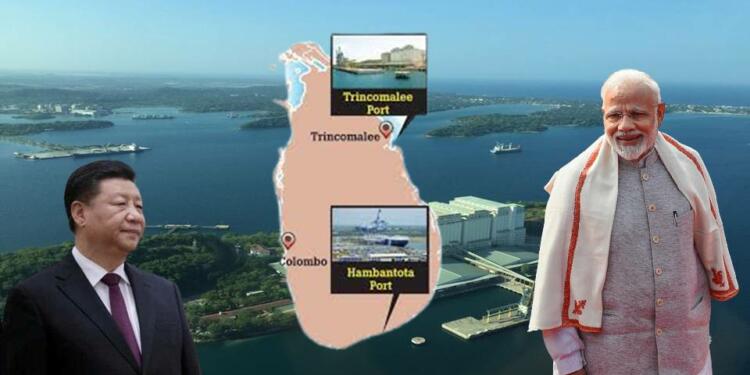Sri Lanka has witnessed a lot in the last few months. Its Prime Minister was overthrown, the central bank exhausted of dollars, and the people suffering from an unprecedented economic crisis. Sri Lanka has lost a lot.
However, India has emerged as the true friend of Sri Lanka in its difficult times. The country has already been extended credit lines and currency swaps worth over $3 billion by India.
But, there’s one thing that India has been demanding from Sri Lanka. The demand is that it must avoid sitting on the laps of the Chinese communist government. Sri Lanka, too, seems to have realised its mistake after being debt-trapped by China and has begun working on the line of “India’s first policy.”
Read more: How India’s ‘Necklace of Diamonds’ outsmarted China’s ‘String of Pearls’ in the Indian Ocean
The improving relations can help India to have an opportunity for maintaining its stronghold in Sri Lanka through Trincomalee port – Sri Lanka’s new project that can be strategically important for India.
Trincomalee port – an opportunity for India
Sri Lanka has announced that it is planning to develop Trincomalee as an “industrial harbour” and will soon float tenders for this. The economically beleaguered nation will give a couple of thousand hectares of land on lease to set up industries in a special economic zone and the associated development of the strategically located port.
Prasantha Jayamanna, chairman of Sri Lanka Ports Authority, said on Tuesday that “We are actually planning to go for an Expression of Interest (EoI) to develop Trincomalee Port as an industrial port. That means we will be asking not only from one party, but whoever the industrialists are who want to come and utilise the port premises. We have large land, some 2,400 hectares, that surrounds the port of Trincomalee.”
Trincomalee port stirring up geopolitical interest
Reportedly, “The proposal to develop an industrial harbour in Trincomalee is a long-standing plan to monetise land that belongs to the Sri Lanka Port Authority, by getting foreign and local investment for a special economic zone, an industrial park, or an energy hub.”
India has already made a substantial investment in Trincomalee and is likely to be investing in the project as it could turn out to be strategically helpful for India. Apart from India, the development of Trincomalee port has been stirring up geopolitical interests in multiple countries, including Japan and the US.
India should correct the blunders of Hambantota
The development of Trincomalee port is not only an opportunity for India to gain a stronghold over the Indian Ocean region but can also help the nation to correct the blunders of Hambantota. The port offered not just one of Asia’s finest natural harbours but is an opportunity to balance China’s influence in the country. It will also help India dominate the maritime trade routes in the region as it will lead to involvement in Colombo port for container traffic and Hambantota port for cargo.
Hambantota Port, on the contrary, has been a living, breathing example of China’s invasive debt-trap diplomacy. The controversial project came up during the tenure of former President Mahinda Rajapaksa and it was a major reason behind the deterioration of Indo-Sri Lanka relations.
Since the project was not feasible, India had denied financing it. Financed by the Chinese despite adverse feasibility reports and refusal by India for such a project, the port turned out to be a miserable failure.
While it became an example of Chinese “debt-trap” diplomacy, the port also became a matter of grave concern for India as it ensured Chinese presence at a strategic location in the Indian Ocean region.
What added to India’s woes was the fact that Sri Lanka after being unable to pay off the debt handed over the port and a mammoth 15,000 acres of land around it to the Chinese on a 99-year lease. This was strategically crucial for China as it gained a foothold just a few hundred miles off the shores of India.
In the name of Trincomalee Port, India now has an opportunity and it must make the most out of it to throw China out of the Indian Ocean region.





























